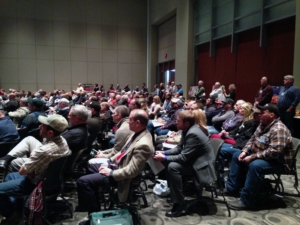For tree fruit growers, the first day of the Great Lakes Fruit, Vegetable, and Farm Market Expo featured talks on pest control, protecting pollinators, and an introduction to the soil microbe community and how it can impact tree productivity.

Attendees at Michigan show. Photo by Kate Prengaman/GFG
Thanks to DNA tools, scientists are learning a lot about what microbes are found in trees’ root zone but for the most part “what we don’t know is what they heck they are doing,” said Mark Mazzola, a pathologist for the U.S. Department of Agriculture’s Tree Fruit Research Laboratory in Wenatchee, Washington. Many remain mysterious, but researchers have found microbes that fix nitrogen, secrete compounds that stimulate root growth, and protect plants against disease.
“People really characterize the soil microbiome as the first line of defense against soil borne pathogens,” Mazzola said.
So how do we harness the microbiome to benefit production? There are synthetic products you can buy, but Mazzola cautions that they tend to have pretty narrow applications and may not always jive with the existing soil community. Boosting that native community through nutrition, planting decisions, and alternatives to fumigation such as mustard seed meal is more likely to create a more resilient orchard system, he said.
In experiments in Washington with mustard meal, “We’ve provided the environment where we can suppress the lesion nematode through modification of the microbiome,” he said.
When it comes to pests that are a little more obvious, Anne Nielsen, an entomologist at Rutgers University, talked about controlling brown marmorated stink bugs in stone fruit. New Jersey was the epicenter of the invasive pest’s boom in 2010 and while they will forage on any plant with a fruit, peaches are a favorite, Nielsen said.
Through her research, she showed growers that spraying just the perimeter of their orchards – in 5 or 10 acre blocks – weekly is enough to stop an invasion of BMSB, and saves both time and insecticide compared to alternate row middle spraying.
Nielsen also recommends putting your BMSB traps at orchard edges because that’s where the pest is more likely to be found and because the attractant pheromone can lure the pest to nearby trees as well as the lure.
Finding the right location is also an important part of protecting the pollinators working in your orchard. Make sure to put honeybee hives in an upwind location from your orchard so they are not in danger from drift, said Julianna Wilson, tree fruit outreach specialist for the Michigan State University entomology department.
Scientists now know that some fungicides, which were thought to be safe for bees, actually have sub-lethal effects than can lead to poor feeding, stress, and disease susceptibility for the colonies, Wilson said. So, it’s important to keep bees in mind when you spray during bloom to protect trees from diseases like cherry leaf spot and apple scab, she said. Keeping hives at a safe distance – bees will find those delicious flowers from more than a mile away – calibrating sprayers to minimize drift, and spraying on cool days or after dusk will all help protect pollinators.






Leave A Comment